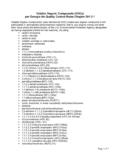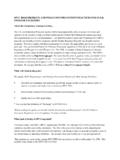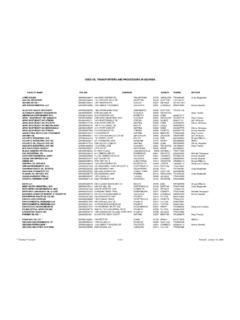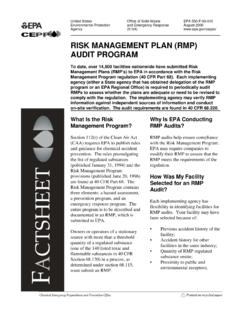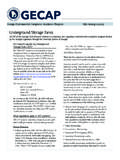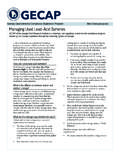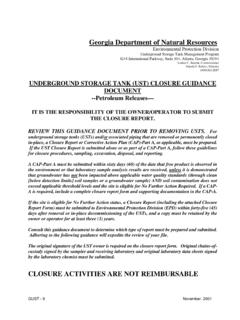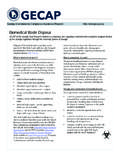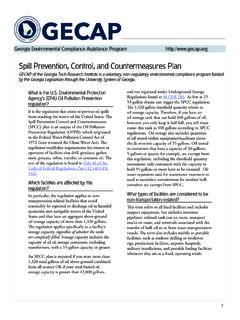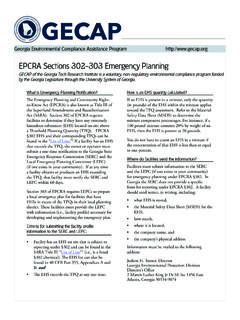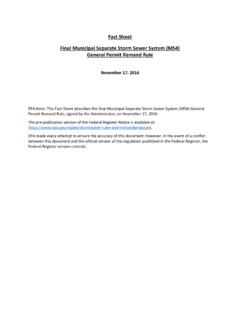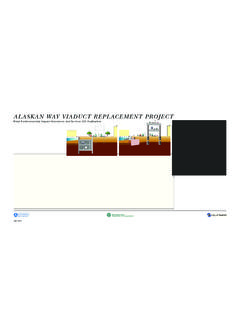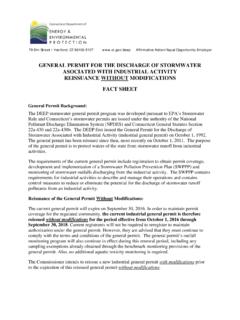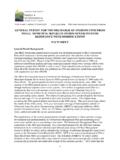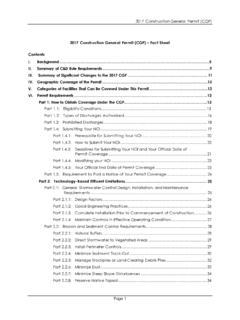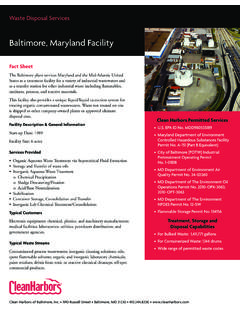Transcription of Fact Sheet NPDES Permit - GECAP | Georgia Environmental ...
1 1 State of Georgia Department of Natural Resources Environmental Protection Division fact Sheet national pollutant discharge elimination system ( NPDES ) General Permit No. GAR050000 Storm Water Discharges Associated with Industrial Activity January 17, 2012 Introduction This fact Sheet describes the basis and procedures for reissuance of Georgia s 2006 NPDES General Storm Water Permit (GAR000000) as the proposed 2012 NPDES General Storm Water Permit (GAR050000) for discharges of storm water associated with industrial activity.
2 This Permit is referred to as the 2012 IGP. The current Permit (2006 IGP) expired July 31, 2011; however, the 2006 IGP continues in force and effect (Part VII. B) until the proposed Permit becomes effective. An NPDES Permit was first issued for industrial storm water in Georgia in 1993; it was reissued in 1998. In 2003, the 1998 Permit expired and was administratively extended. A draft Permit was issued for public comment in 2004, which was subsequently revised and reissued in 2005. The 2005 Permit was appealed.
3 The 2006 IGP was issued August 1, 2006, incorporating the results of two settlement agreements. Permit Basis The 2012 IGP authorizes all new and existing storm water point sources within Georgia to discharge storm water associated with industrial activity, excluding construction, to the waters of the State upon submittal of a Notice of Intent (NOI). The 2012 IGP is in compliance with, and is based upon, the provisions of the Georgia Water Quality Control Act ( Georgia Laws 1964, p. 416, as amended, State Act ), the Federal Clean Water Act, as amended (33 et seq.)
4 , Clean Water Act ), and the Rules and Regulations promulgated subsequent to each of these Acts. The proposed Permit is patterned after the Environmental Protection Agency (EPA) Multi-Sector General NPDES Permit (2008 MSGP) for industrial storm water issued September 29, 2008. The 2008 MSGP is available at: ; and the EPA fact Sheet for the 2008 MSGP is available at: The 2012 IGP is reformatted and renumbered from previous permits. The numbering system is very similar to the 2008 MSGP. Parts 1 through 7 and Appendices A, B and D contain information pertinent to all permittees.
5 Part 8 contains the sector specific requirements; typically one, or at most a few, of the sectors in Part 8 will apply to any one permittee. Appendix C contains information for those permittees who discharge to impaired stream segments. Appendix E addresses hardness testing for facilities with the hardness dependent benchmark values cadmium, copper, lead, nickel and zinc. 2 The 2012 IGP benchmark values and recommended procedures, practices, control measures and best management practices (BMPs) are based principally on the 2008 MSGP.
6 Activities Covered by the Permit The following table is the list of categories of industrial facilities that are required to obtain NPDES Permit coverage for storm water discharges as identified in 40 CFR Part (b)(14)(i) through (ix) and (xi): Sector A: Timber Products Sector O: Steam Electric Generating Facilities Sector B: Paper and Allied Products Sector P: Land Transportation and Warehousing Sector C: Chemical and Allied Products Manufacturing Sector Q: Water Transportation: Maintenance/Cleaning Sector D: Asphalt Paving and Roofing Materials and Lubricant Manufacturing Sector R: Ship and Boat Building and Repairing Yards Sector E: Glass, Clay, Cement, Concrete, and Gypsum Products Sector S: Air Transportation Facilities Sector F: Primary Metals Sector T: Treatment Works Sector G: Transportation Equipment, Industrial or Commercial Machinery Sector U: Food and Kindred Products Sector H: Electronic, Electrical, Photographic, and Optical Goods Sector V: Textile Mills, Apparel, and Other Fabric Products.
7 Leather and Leather Products Sector I: Oil and Gas Extraction Sector W: Furniture and Fixtures Sector J: Mining and Dressing Sector X: Printing and Publishing Sector K: Hazardous Waste Treatment, Storage, or Disposal Facilities Sector Y: Rubber, Miscellaneous Plastic Products, and Miscellaneous Manufacturing Industries Sector L: Landfills, Land Application Sites, and Open Dumps Sector Z: Leather Tanning and Finishing Sector M: Automobile Salvage Yards Sector AA: Fabricated Metal Products Sector N: Scrap Recycling Facilities Sector AB: Non-Classified Facilities A more specific and detailed listing of facilities required to obtain coverage under the 2012 IGP is contained in Appendix D of the Permit , which includes the SIC Codes associated with the facilities shown in the table above.
8 In addition to the facilities classified as requiring coverage under the 2012 IGP by SIC Code, EPD may designate a particular facility to obtain coverage under the 2012 IGP, even though the facility does not meet the definition of a category of activities generally required to be covered by the Permit . This corresponds with Sector AB. Such a designation would be made by the Director of EPD where there is a concern for the discharge to cause a water quality problem. Maintaining Coverage under the 2012 IGP Current permittees are required to submit a new Notice of Intent (NOI) to obtain coverage under the 2012 IGP and to maintain coverage for discharging storm water associated with industrial 3 activities.
9 Facilities previously covered under GAR000000 will have up to 30 days to submit the new NOI for coverage under GAR050000 after the effective date. If a facility failed the benchmark sampling required by Part of the 2006 Permit , then the facility may not be authorized to discharge storm water under the proposed Permit and may be required to apply for an individual NPDES Permit or alternative general Permit . The facility has the options to conduct 12 months of flow-weighted composite sampling to demonstrate the discharge does not cause or contribute to an exceedance of water quality standards (Appendix ) or make the necessary improvements to the facility to achieve the instream water quality standard as an effluent limit within 36 months (Appendix ).
10 Subsector U3 facilities that failed the benchmark sampling required by Part of the 2006 Permit using a TSS benchmark have the option to conduct fecal coliform testing for 12 months to confirm their ability to cause or contribute to an exceedance of the fecal coliform Water Quality Standard, or prevent all exposure to storm water from animal handling areas and/or capture and treat storm events of inches within animal handling areas within 36 months (Appendix and c). Existing facilities which filed under the No Exposure Exclusion (NEE) of the 2006 IGP must submit a new NEE form no later than 30 days after the effective date of the 2012 IGP (Part ) to retain NEE status.
